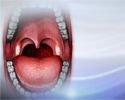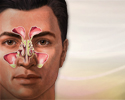Pharyngitis - sore throat
Pharyngitis - bacterial; Sore throatPharyngitis, or sore throat, is discomfort, pain, or scratchiness in the throat. It often makes it painful to swallow.
Causes
Pharyngitis is caused by swelling in the back of the throat (pharynx) between the tonsils and the voice box (larynx).
Most sore throats are caused by colds, the flu, coxsackie virus or mono (mononucleosis).
Flu
The flu (influenza) is a viral respiratory illness that causes fever, chills, runny nose, body aches, and cough. It spreads easily from person to pe...

Mono
Mononucleosis, or mono, is a viral infection that causes fever, sore throat, and swollen lymph glands, most often in the neck.

Bacteria that can cause pharyngitis in some cases:
-
Strep throat is caused by group A streptococcus.
Strep throat
Strep throat is a disease that causes a sore throat (pharyngitis). It is an infection with a bacteria called group A streptococcus.
 ImageRead Article Now Book Mark Article
ImageRead Article Now Book Mark Article - Less commonly, bacterial diseases such as gonorrhea and chlamydia can cause a sore throat.
Gonorrhea
Gonorrhea is a common sexually transmitted infection (STI).
Read Article Now Book Mark ArticleChlamydia
Chlamydia is an infection caused by the bacteria Chlamydia trachomatis. It is most often spread through sexual contact.
 ImageRead Article Now Book Mark Article
ImageRead Article Now Book Mark Article
Most cases of pharyngitis occur during the colder months. The illness often spreads among family members and close contacts.
Symptoms
The main symptom is a sore throat.
Other symptoms may include:
-
Fever
Fever
Fever is the temporary increase in the body's temperature in response to a disease or illness. A child has a fever when the temperature is at or abov...
 ImageRead Article Now Book Mark Article
ImageRead Article Now Book Mark Article -
Headache
Headache
A headache is pain or discomfort in the head, scalp, or neck. Serious causes of headaches are rare. Most people with headaches can feel much better...
 ImageRead Article Now Book Mark Article
ImageRead Article Now Book Mark Article -
Joint pain and muscle aches
Muscle aches
Muscle aches and pains are common and can involve more than one muscle. Pain due to muscles can also be felt in ligaments, tendons, and fascia. Fas...
 ImageRead Article Now Book Mark Article
ImageRead Article Now Book Mark Article -
Skin rashes
Skin rashes
Rashes involve changes in the color, feeling or texture of your skin.
 ImageRead Article Now Book Mark Article
ImageRead Article Now Book Mark Article -
Swollen lymph nodes (glands) in the neck
Swollen lymph nodes
Lymph nodes are present throughout your body. They are an important part of your immune system. Lymph nodes help your body recognize and fight germ...
 ImageRead Article Now Book Mark Article
ImageRead Article Now Book Mark Article
Exams and Tests
Your health care provider will perform a physical exam and look at your throat.
A rapid test or throat culture to test for strep throat may be done. Other lab tests may be done, depending on the suspected cause. It is important to test for HIV (human immunodeficiency virus) if you have been exposed to HIV and have a sore throat.
Throat culture
A throat swab culture is a laboratory test that is done to identify germs that may cause infection in the throat. It is most often used to diagnose ...

HIV
Human immunodeficiency virus (HIV) is the virus that causes acquired immunodeficiency syndrome (AIDS). When a person becomes infected with HIV, the ...

Treatment
Most sore throats are caused by viruses. Antibiotics do not help viral sore throats. Using these medicines when they are not needed may lead to antibiotics not working as well when they are needed.
A sore throat is treated with antibiotics if:
- A strep test or culture is positive. Your provider cannot diagnose strep throat by symptoms or a physical exam alone.
- A culture for chlamydia or gonorrhea is positive.
A sore throat caused by the flu (influenza) may be helped by antiviral medicines.
The following tips may help your sore throat feel better:
- Drink soothing liquids. You can either drink warm liquids, such as lemon tea with honey, or cold liquids, such as ice water. You could also suck on a fruit-flavored ice pop.
- Gargle several times a day with warm salt water (1/2 teaspoon or 3 grams of salt in 1 cup or 240 milliliters of water).
- Suck on hard candies or throat lozenges. Young children should not be given these products because they can choke on them.
- Use of a cool-mist vaporizer or humidifier can moisten the air and soothe a dry and painful throat.
- Try over-the-counter pain medicines, such as acetaminophen (Tylenol) or ibuprofen (Advil, Motrin).
Possible Complications
Complications may include:
-
Ear infection
Ear infection
Suspected ear infections are one of the most common reasons parents take their children to their health care provider. The most common type of ear i...
 ImageRead Article Now Book Mark Article
ImageRead Article Now Book Mark Article -
Sinusitis
Sinusitis
Sinusitis is present when the tissue lining the sinuses become swollen or inflamed. It occurs as the result of an inflammatory reaction or an infect...
 ImageRead Article Now Book Mark Article
ImageRead Article Now Book Mark Article -
Abscess near the tonsils
Abscess
An abscess is a collection of pus in any part of the body. In most cases, the area around an abscess is swollen and inflamed.
 ImageRead Article Now Book Mark Article
ImageRead Article Now Book Mark Article
When to Contact a Medical Professional
Contact your provider if:
- You develop a sore throat that does not go away after several days
- You have a high fever, swollen lymph nodes in your neck, or a rash
Seek medical care right away if you have a sore throat and trouble breathing.
References
Flores AR. Pharyngitis. In: Blaser MJ, Cohen JI, Holland SM, et al, eds. Mandell, Douglas, and Bennett's Principles and Practice of Infectious Diseases. 10th ed. Philadelphia, PA: Elsevier; 2026:chap 61.
Gigante J. Acute pharyngitis. In: Kliegman RM, St. Geme JW, Blum NJ, et al, eds. Nelson Textbook of Pediatrics. 22nd ed. Philadelphia, PA: Elsevier; 2025:chap 430.
van Driel ML, De Sutter AI, Thorning S, Christiaens T. Different antibiotic treatments for group A streptococcal pharyngitis. Cochrane Database Syst Rev. 2021;3:CD004406. PMID: 33728634 www.ncbi.nlm.nih.gov/pubmed/33728634/.
-
Throat anatomy - illustration
Structures of the throat include the esophagus, trachea, epiglottis and tonsils.
Throat anatomy
illustration
-
Swollen lymph node - illustration
Lymph nodes play an important part in the body's defense against infection. Swelling might occur even if the infection is trivial or not apparent. Swelling of lymph nodes generally results from localized or systemic infection, abscess formation, or malignancy.
Swollen lymph node
illustration
-
Throat anatomy - illustration
Structures of the throat include the esophagus, trachea, epiglottis and tonsils.
Throat anatomy
illustration
-
Swollen lymph node - illustration
Lymph nodes play an important part in the body's defense against infection. Swelling might occur even if the infection is trivial or not apparent. Swelling of lymph nodes generally results from localized or systemic infection, abscess formation, or malignancy.
Swollen lymph node
illustration
Review Date: 7/3/2025
Reviewed By: Linda J. Vorvick, MD, Clinical Professor Emeritus, Department of Family Medicine, UW Medicine, School of Medicine, University of Washington, Seattle, WA. Also reviewed by David C. Dugdale, MD, Medical Director, Brenda Conaway, Editorial Director, and the A.D.A.M. Editorial team.





